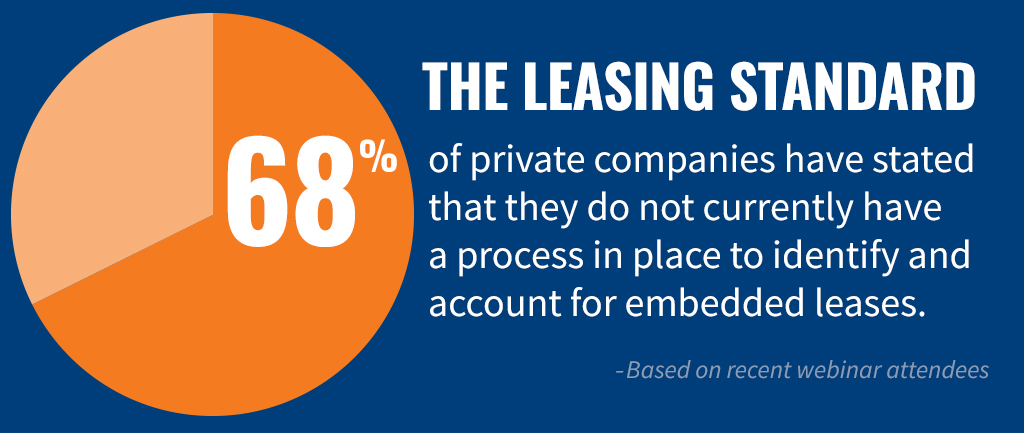In our prior lease accounting article, we reported on significant challenges companies face when implementing Topic 842, the FASB’s new lease accounting standard. Our goal for that article was to provide perspective on some of the implementation challenges private companies can expect to encounter. Public companies will be adopting the new lease accounting standard in 2019, with private companies following in 2020. As the effective date of the new standard inches ever closer, we continue to urge private companies to devise and begin executing their transition strategies now, leaving ample time to address unforeseen challenges. We believe that applying a wait-and-see approach is not the best course of action, and could result in your transition efforts getting bogged down in unforeseen quicksand.
To recap, Topic 842 brings most operating leases on to lessee balance sheets, requiring lessees to recognize liabilities reflecting the discounted amount of lease payments payable over the lease term. Previously, only capital leases were required to be recognized on the lessee balance sheets. The new standard also modifies the definition of a lease and provides that part of a contract can meet that definition.
Through assisting and advising public companies in their transition efforts, we have observed implementation-related risks and issues. We believe it is in the best interest of an organization to understand, evaluate, and address them. We also believe that private companies, which may have more IT system constraints and less robust reporting functions when compared to public companies, may face an elevated level of exposure to these risks and issues. In addition, non-public organizations may not have the depth and breadth of in-house expertise necessary for developing and executing an effective transition strategy to avoid critical missteps, especially when considering the demands of other organizational priorities. Here are some of the risks we are discussing with our clients.

Risk: Embedded Leases
A part or portion of a contract can meet the definition of a lease under Topic 842. This requires companies to identify right to use (ROU) assets that could be embedded within seemingly non-lease transactions, e.g. service contracts that may require an asset to service the contract. Such leases are accounted for by recognizing a lease liability reflecting the discounted amount of future lease payments, and a corresponding right of use asset. Companies are required to determine an appropriate discount rate for measuring lease liabilities, which will be recognized by lessees for most of their leases, including those classified as operating.
Prior to Topic 842, this exercise was less prominent because operating leases were accounted for off-balance sheet. That has changed under the new standard, highlighting the prominence of identifying embedded leases which will generally be on-balance sheet. Embedded lease identification may sound like a straight-forward exercise, but it could become complicated when contracts are often reviewed and signed by various individuals in different departments throughout an organization who may not be conversant with the accounting nuances. This could be compounded by situations involving a lease embedded within, for example, a service contract. Identifying such embedded leases will entail a thorough understanding and evaluation of the contractual arrangements.
TREATING ANXIETY OVER EMBEDDED LEASES
A well-designed transition strategy and thoughtful execution thereof will remedy embedded lease anxiety. Further, crafting relevant accounting policies will go a long way toward mitigating minutia. Identifying and accounting for embedded leases can be a tedious and potentially time consuming task, involving thoroughly understanding each contract and tracking contractual terms and conditions. It also requires the judgment of staff, whom may require training.
A “SAFE HARBOR” PROVISION THAT ISN’T SAFE
We expect most companies to elect a package of practical expedients when transitioning to Topic 842. Among other things, electing this package of practical expedients allows an organization to avoid re-evaluating expired or existing contracts for embedded leases. However, this exclusion cannot be used to ignore past accounting errors. Electing this package of practical expedients to willfully avoid past errors from coming to light could harm your E&O coverage and poses reputational risk.
Risk: Discount Rates
Under the new standard, lessees and lessors are required to use the rate implicit in the lease when discounting future lease payments. If that rate cannot be reasonably determined, lessees must use their incremental borrowing rates. Determining company-specific incremental borrowing rates will be challenging, especially for lessees that do not frequently issue debt or that conduct their treasury operations in a decentralized way. Incremental borrowing rates reflect, among other things, lessee credit risk, lease term, the amount of lease payments, and the impact of ‘posted collateral’. Early on, private companies should devise an integrated approach to determining appropriate discount rates when applying Topic 842.Risk: Debt Covenants
Many companies have debt arrangements containing loan covenants that, if violated, trigger a default by the borrower. Companies may also have agreements containing cross-default provisions or material adverse change clauses that could be negatively impacted by an actual or constructive default under an unrelated agreement, such as in a loan default. Since lease liabilities will be recognized for most operating leases under Topic 842, companies should assess whether their existing covenants will be effected.Risk: Internal Controls
Many companies perform their accounting for lease arrangements using spreadsheets. Over time, this could have resulted in inconsistency with respect to how the data is maintained and managed. Lessee usage of spreadsheets to perform the calculations required by the new standard increases the risk of accounting and financial reporting errors. Regardless of the medium used, internal controls supporting those calculations should be enhanced to support the information and calculations required by the new standard, including information needed for financial statement disclosure.
There are many vendors offering to sell software designed to automate implementation of the new standard. Unfortunately, many private companies do not have the enterprise reporting (ERP) systems in place to support these software solutions. For private companies seeking to upgrade their current ERP systems, such solutions may not be the right fit because there is likely little or no benefit to building on top of an ERP system that may soon be obsolete. Further, decisions about ERP systems are made in contemplation of the entire enterprise, not just the accounting and finance departments.
While there are many lease software solutions available, it is also difficult to know which one will be best for your organization. Without the right system in place, the ability to store lease data and use it appropriately will diminish as the sheer volume of data increases. This makes the data difficult to retrieve, which inhibits the usage of such data to gain valuable insights into internal processes and market trends.
This issue is especially critical for industries working to overcome Industry 4.0 challenges. Companies that are planning to automate all their other processes must bring in a platform that will speak to all their other systems and provide cost-saving opportunities. It is also important to consider the ability of the software vendor to provide a SSAE 18 report, since the leasing systems provide calculations that are used for public reporting purposes.
Risk: Staffing, Training and Timeline
Delaying implementation of Topic 842 may be the biggest risk of all. The most obvious one is the need to ferret out, categorize and standardize a process for reviewing perhaps hundreds or thousands of documents within a short timeframe. This could require extensive training and staff time, for a one-time-only project. Alternatively, most companies will be looking to hire an external firm as the deadline draws nearer. We believe at that juncture most of the qualified bandwidth will be taken, especially in the current tight labor environment.
Topic 842 implementation could require extensive changes in systems and operations, a process that will require time, money, and top talent. Therefore, it is better to lock up the talent sooner rather than later. Organizations that begin planning today can reap risk management benefits and be better positioned to realized efficiency gains post-transition.
In our next article, as part of our Lease Accounting – Your Guide through Change series, we will run a high-level refresher on Topic 842, diving into the reasoning behind the new standard as well as the overall impact to organizations across the nation, and the world.

Matthew Derba
Contact
Let’s start a conversation about your company’s strategic goals and vision for the future.
Please fill all required fields*
Please verify your information and check to see if all require fields have been filled in.

Lease Accounting Resource Center

On-Demand Webinar: The Leasing Standard Maintaining Momentum Through The Final Stages











